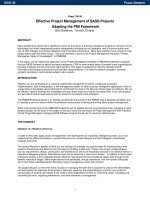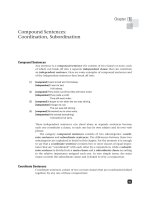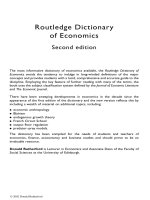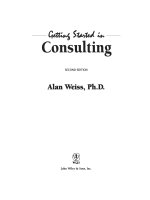Effective Project Management Traditional, Adaptive, Extreme Third Edition phần 1 pot
Bạn đang xem bản rút gọn của tài liệu. Xem và tải ngay bản đầy đủ của tài liệu tại đây (1.95 MB, 50 trang )
Robert K. Wysocki, Ph.D.
with contributions by
Rudd McGary, Ph.D.,PMP
Effective Project
Management
Traditional, Adaptive, Extreme
Third Edition
01 432210 FM.qxd 7/2/03 9:31 AM Page i
Executive Publisher: Robert Ipsen
Vice President and Publisher: Joe Wikert
Executive Editor: Robert M. Elliott
Developmental Editor: Kevin Kent
Editorial Manager: Kathryn A. Malm
Production Editor: Felicia Robinson
Media Development Specialists: Megan Decraene and Kit Malone
Text Design & Composition: Wiley Composition Services
Copyright © 2003 by Robert Wysocki, Rudd McGary. All rights reserved.
Published by Wiley Publishing, Inc., Indianapolis, Indiana
Published simultaneously in Canada
No part of this publication may be reproduced, stored in a retrieval system, or transmitted
in any form or by any means, electronic, mechanical, photocopying, recording, scanning, or
otherwise, except as permitted under Section 107 or 108 of the 1976 United States Copyright
Act, without either the prior written permission of the Publisher, or authorization through
payment of the appropriate per-copy fee to the Copyright Clearance Center, Inc., 222 Rose-
wood Drive, Danvers, MA 01923, (978) 750-8400, fax (978) 646-8700. Requests to the Pub-
lisher for permission should be addressed to the Legal Department, Wiley Publishing, Inc.,
10475 Crosspoint Blvd., Indianapolis, IN 46256, (317) 572-3447, fax (317) 572-4447, E-mail:
Limit of Liability/Disclaimer of Warranty: While the publisher and author have used their
best efforts in preparing this book, they make no representations or warranties with respect
to the accuracy or completeness of the contents of this book and specifically disclaim any
implied warranties of merchantability or fitness for a particular purpose. No warranty may
be created or extended by sales representatives or written sales materials. The advice and
strategies contained herein may not be suitable for your situation. You should consult with
a professional where appropriate. Neither the publisher nor author shall be liable for any
loss of profit or any other commercial damages, including but not limited to special, inci-
dental, consequential, or other damages.
For general information on our other products and services please contact our Customer
Care Department within the United States at (800) 762-2974, outside the United States at
(317) 572-3993 or fax (317) 572-4002.
Trademarks: Wiley, the Wiley Publishing logo and related trade dress are trademarks or
registered trademarks of Wiley Publishing, Inc., in the United States and other countries,
and may not be used without written permission. All other trademarks are the property of
their respective owners. Wiley Publishing, Inc., is not associated with any product or ven-
dor mentioned in this book.
Wiley also publishes its books in a variety of electronic formats. Some content that appears
in print may not be available in electronic books.
Library of Congress Cataloging-in-Publication Data:
ISBN: 0-471-43221-0
Printed in the United States of America
10 9 8 7 6 5 4 3 2 1
01 432210 FM.qxd 7/2/03 9:31 AM Page ii
ACKNOWLEDGMENTS
iii
T
his acknowledgment is really a special acknowledgment to two people who
played a key role in getting this whole project started. First, Dave Crane and I
had cofacilitated a three-day project management course for Boston University
Corporate Education Center clients. Dave and I honed the course materials
over a three-year period and then decided to turn it into a book. At that time,
Bob Beck, who was recently retired after 25 years with IBM, was my business
partner and volunteered to create the CD-ROM that would house the O’Neill
& Preigh Church Equipment Manufacturers case study. Dave and Bob devoted
most of their efforts to the case study and the CD-ROM, while I focused on the
contents of the book. Our three-person team worked very well together and
produced the first edition. In time, and after healthy sales of the first edition,
we decided to do a second edition. That has been even more successful than
the first edition. Bob has retired now and spends most of his time fishing and
helping his missionary church build facilities in South America. Dave is fully
occupied delivering training for Boston University. I’m still actively involved
in project management consulting and writing. We’ve kind of gone our sepa-
rate ways. I owe both of these friends and colleagues my heartfelt thanks for
giving so freely of their time and energies. All three of us can look back with
no regrets and know that we have done great work together.
Now it’s time for the third edition. I’ve decided to retire O’Neill & Preigh; that
case served us well. In its place there is a new case, the Jack Neift Trucking
Company, and a new team member, Rudd McGary. I’ve learned a lot working
with Dave and Bob and would like to think that that learning is reflected in
this third edition.
01 432210 FM.qxd 7/2/03 9:31 AM Page iii
01 432210 FM.qxd 7/2/03 9:31 AM Page iv
PREFACE
v
Preface to the Third Edition
S
omeone once said, “If it ain’t broke, fix it.” The second edition has been very
successful, and for that we are grateful. It ain’t broke. But so much is happen-
ing in the world of projects and project management that it is time to fix it. The
third edition represents a major updating of a very successful second edition.
Comments from our readers and the significant changes taking place in the
project management landscape are what prompted the writing of the third edi-
tion. For those who have followed this book through the previous editions and
have become our loyal readers, we are offering a fresh and greatly expanded
third edition. You will find that a few totally new topics are introduced here for
the first time, that a number of contemporary topics have also been added, and
that a number of continuing topics have had a fresh coat of paint applied. We
hope that you will be pleased with the results.
There are two significant changes on the cover:
■■
First, note the title change. We have added Traditional, Adaptive, Extreme as
a subtitle. The material from the second edition of this title is mostly con-
tained in the part devoted to the traditional approach to project manage-
ment. There are now discussions in the book devoted to the adaptive and
extreme approaches to project management. These discussions are new in
the third edition. The part devoted to the adaptive approach is totally
new. It has not been published elsewhere.
■■
Second, note the change in authors. Bob Beck and Dave Crane are no
longer listed as authors and have moved on to other adventures and have
been replaced by Rudd McGary. Rudd is a veteran and brings years of
project management consulting and training experience to the team.
Welcome aboard, Rudd!
Rudd’s major contribution is the replacement of the O’Neill & Preigh case
study from the second edition with a fresh new case, Jack Neift Trucking Com-
pany. The CD-ROM that accompanies this book still contains the exercises
much like the second edition, but the text itself also contains a number of dis-
cussion questions related to the chapter materials and to the case study as well.
01 432210 FM.qxd 7/2/03 9:31 AM Page v
This material is also new with the third edition. Much to our surprise the book
has been widely adopted in undergraduate, graduate, and continuing educa-
tion programs. The second edition was not written as a college text, but
because of the numerous college adoptions, we have decided to write the third
edition as both a reference and as a text. Many college faculty have written and
asked for our support. We were cognizant of that need as we prepared this
edition. That is why we’ve added more exercises and thought-provoking
discussion questions that should add a bit of excitement to class lectures.
Additionally, many of the requests for help asked for copies of the figures, so
the CD-ROM contains PowerPoint slides of every figure and table in the book.
We would like to think that this edition offers you a complete view of effective
project management as it is now practiced and how it should be practiced in
the very near future.
Thank you again for adding our book to your project management library. If
you have any questions or would just like to comment, you may contact me at
and Rudd at
Enjoy!
Robert K. Wysocki, Ph.D.
Rudd McGary, Ph.D.
Effective Project Management, Third Edition
vi
01 432210 FM.qxd 7/2/03 9:31 AM Page vi
CONTENTS
vii
Acknowledgments iii
Preface v
About the Authors xix
Introduction xxi
Part One Traditional Project Management 1
Chapter 1 What Is a Project? 3
Defining a Project 3
Sequence of Activities 4
Unique Activities 4
Complex Activities 4
Connected Activities 5
One Goal 5
Specified Time 5
Within Budget 5
According to Specification 6
What Is a Program? 6
Project Parameters 7
Scope 7
Quality 8
Cost 8
Time 8
Resources 9
The Scope Triangle 9
Scope Creep 11
Hope Creep 11
Effort Creep 11
Feature Creep 12
Project Classifications 12
Classification by Project Characteristics 13
Classification by Project Type 15
Putting It All Together 15
Discussion Questions 16
01 432210 FM.qxd 7/2/03 9:31 AM Page vii
Chapter 2 What Is Traditional Project Management? 17
Principles of Traditional Project Management 17
Defining 18
Planning 19
Executing 20
Controlling 21
Closing 21
Traditional Project Management Life Cycle 22
Phases of Traditional Project Management 23
Levels of Traditional Project Management 28
Quality Management 29
Continuous Quality Management Model 30
Process Quality Management Model 30
Risk Management 33
Identifying Risk 34
Assessing Risk 35
Planning Risk Response 35
Risk Monitoring and Control 36
Risk Assessment Example 37
Procurement Management 38
Planning Procurement 39
Soliciting Requests for Proposals 40
Managing RFP Questions and Responses 41
Selecting Vendors 41
Managing Contracts 42
Closing Out the Contract 43
Relationship between Traditional Project
Management and Other Methodologies 43
The Pain Curve 44
Putting It All Together 48
Discussion Questions 48
Chapter 3 Scoping the Project 49
Defining the Project 49
Managing Client Expectations 50
Sorting Wants versus Needs 51
Developing Conditions of Satisfaction 51
Conducting Milestone Reviews 54
Creating the Project Overview Statement 55
Parts of the POS 56
Attachments 64
Using the Joint Project Planning Session
to Develop the POS 67
Effective Project Management, Third Edition
viii
01 432210 FM.qxd 7/2/03 9:31 AM Page viii
Submitting a Project for Approval 67
Participants in the Approval Process 69
Approval Criteria 70
Project Approval Status 71
The Project Definition Statement 71
Putting It All Together 72
Discussion Questions 72
Chapter 4 Identifying Project Activities 75
The Work Breakdown Structure 75
Uses for the WBS 78
Generating the WBS 79
Top-Down Approach 79
Bottom-Up Approach 81
WBS for Small Projects 82
Intermediate WBS for Large Projects 83
Six Criteria to Test for Completeness in the WBS 84
Measurable Status 84
Bounded 85
Deliverable 86
Cost/Time Estimate 86
Acceptable Duration Limits 86
Activity Independence 86
Using a Joint Project Planning Session to Build the WBS 87
Approaches to Building the WBS 88
Noun-Type Approaches 89
Verb-Type Approaches 90
Organizational Approaches 91
Representing the WBS 91
Putting It All Together 95
Discussion Questions 95
Chapter 5 Estimating Duration, Resource Requirements, and Cost 97
Estimating Duration 97
Resource Loading versus Activity Duration 99
Variation in Activity Duration 101
Six Methods for Estimating Activity Duration 102
Estimation Precision 106
Estimating Resource Requirements 106
People as Resources 107
Resource Breakdown Structure 108
Estimating Duration as a Function of Resource Availability 109
Assign as a Total Work and a Constant Percent/Day 109
Assign as a Duration and Total Work Effort 110
Contents
ix
01 432210 FM.qxd 7/2/03 9:31 AM Page ix
Assign as a Duration and Percent/Day 110
Assign as a Profile 110
Estimating Cost 111
Resource Planning 111
Cost Estimating 112
Cost Budgeting 113
Cost Control 113
Using a JPP Session to Estimate Duration,
Resource Requirements, and Cost 114
Determining Resource Requirements 115
Determining Cost 115
Putting It All Together 116
Discussion Questions 116
Chapter 6 Constructing and Analyzing the Project Network Diagram 117
The Project Network Diagram 117
Envisioning a Complex Project Network Diagram 118
Benefits to Network-Based Scheduling 119
Building the Network Diagram Using
the Precedence Diagramming Method 121
Dependencies 123
Constraints 125
Using the Lag Variable 129
Creating an Initial Project Network Schedule 129
Analyzing the Initial Project Network Diagram 135
Compressing the Schedule 135
Management Reserve 137
Using the JPP Session to Construct
and Analyze the Network 139
Putting It All Together 141
Discussion Questions 142
Chapter 7 Finalizing the Schedule and Cost Based on
Resource Availability 143
Considering Resource Availability 143
Leveling Resources 144
Acceptably Leveled Schedule 146
Resource-Leveling Strategies 147
Utilizing Available Slack 147
Shifting the Project Finish Date 147
Smoothing 148
Alternative Methods of Scheduling Activities 148
Cost Impact of Resource Leveling 150
Implementing Micro-Level Project Planning 151
Effective Project Management, Third Edition
x
01 432210 FM.qxd 7/2/03 9:31 AM Page x
Work Packages 153
Purpose of a Work Package 153
Format of a Work Package 154
Putting It All Together 157
Discussion Questions 157
Chapter 8 Organizing and Conducting the Joint Project
Planning Session 159
Joint Project Planning Sessions 159
Planning the JPP Session 160
Attendees 161
Facilities 164
Equipment 164
The Complete Planning Agenda 164
Deliverables 165
Project Proposal 166
Contents of the Project Proposal 166
Putting It All Together 168
Discussion Questions 168
Chapter 9 Recruiting, Organizing, and Managing the Project Team 169
Project Manager vis-à-vis the Functional Manager 170
Projects as Motivation and Development Tools 171
Motivators 172
Hygiene Factors 172
Recruiting the Project Team 175
The Project Manager 175
Core Team Members 178
Contracted Team Members 181
Organizing the Project Team 185
Authority 185
Responsibility 186
Balancing a Team 186
Developing a Team Deployment Strategy 187
Developing a Team Development Plan 188
Establishing Team Operating Rules 188
Situations Requiring Team Operating Rules 189
Problem Solving 190
Decision Making 192
Conflict Resolution 196
Consensus Building 197
Brainstorming 198
Team Meetings 199
Managing Team Communications 200
Managing Communications Timing, Content, and Channels 200
Managing Communication Beyond the Team 203
Contents
xi
01 432210 FM.qxd 7/2/03 9:31 AM Page xi
Putting It All Together 206
Discussion Questions 206
Chapter 10 Monitoring and Controlling Progress 207
Control versus Risk 207
Purpose of Controls 208
High Control—Low Risk 209
Low Control—High Risk 209
Balancing the Control System 210
Control versus Quality 211
Progress Reporting System 211
Types of Project Status Reports 211
How and What Information to Update 215
Frequency of Gathering and Reporting Project Progress 216
Variances 217
Applying Graphical Reporting Tools 218
Gantt Charts 218
Milestone Trend Charts 219
Cost Schedule Control 222
Using the WBS to Report Project Status 228
Deciding on Report Level of Detail 230
Activity Manager 230
Project Manager 230
Senior Management 231
Managing Project Status Meetings 231
Who Should Attend? 231
When Are They Held? 232
What Is Their Purpose? 232
What Is Their Format? 233
Managing Change 234
Managing Problem Escalation 237
The Escalation Strategy Hierarchy 239
Problem Management Meetings 240
Putting It All Together 241
Discussion Questions 241
Chapter 11 Closing Out the Projects 243
Steps in Closing a Project 243
Getting Client Acceptance 244
Ceremonial Acceptance 244
Formal Acceptance 244
Installing Project Deliverables 245
Documenting the Project 245
Post-Implementation Audit 246
Effective Project Management, Third Edition
xii
01 432210 FM.qxd 7/2/03 9:31 AM Page xii
The Final Report 249
Celebrating Success 249
Putting It All Together 250
Discussion Questions 250
Chapter 12 Critical Chain Project Management 251
What Is the Critical Chain? 252
Variation in Duration: Common Cause versus Special Cause 252
Statistical Validation of the Critical Chain Approach 253
The Critical Chain Project Management Approach 255
Step 1: Creating the Early Schedule Project Network Diagram 255
Step 2: Converting the Early Schedule to the Late Schedule
and Adding Resources 256
Step 3: Resolving Resource Conflicts 256
Buffers 257
Defining Buffers 258
Types of Buffers 258
Using Buffers 259
Managing Buffers 260
Track Record of Critical Chain Project Management 262
Putting It All Together 263
Discussion Questions 263
Part Two Adaptive Project Framework 265
Chapter 13 Introduction to the Adaptive Project Framework 267
Defining APF 268
An Overview of the APF 269
Version Scope 269
Cycle Plan 272
Cycle Build 273
Client Checkpoint 273
Post-Version Review 274
The APF Core Values 276
Client-Focused 276
Client-Driven 276
Incremental Results Early and Often 277
Continuous Questioning and Introspection 277
Change Is Progress to a Better Solution 277
Don’t Speculate on the Future 278
Putting It All Together 278
Discussion Questions 278
Contents
xiii
01 432210 FM.qxd 7/2/03 9:31 AM Page xiii
Chapter 14 Version Scope 279
Defining the Version Scope 281
Developing the Conditions of Satisfaction 281
Writing the Project Overview Statement 283
Holding a Fixed Version Budget and Timebox 285
Planning the Version Scope 286
Developing the Mid-Level WBS 286
Prioritizing the Version Functionality 287
Prioritization Approaches 289
Prioritizing the Scope Triangle 290
Determining the Number of Cycles and Cycle Timeboxes 294
Assigning Functionality to Cycles 295
Writing Objective Statements for Each Cycle 295
Putting It All Together 295
Discussion Questions 296
Chapter 15 Cycle Plan 297
Developing a Low-Level WBS for This Cycle Functionality 299
Micromanaging an APF Project 300
Estimating Task Duration 301
Estimating Resource Requirements 302
Determining Resource Requirements in the WBS 303
Identifying a Specific Resource Needed 303
Sequencing the Tasks 303
Putting It All Together 304
Discussion Questions 304
Chapter 16 Cycle Build 305
Creating a Micro-Level Schedule and Finalizing
Resource Assignments 306
Writing Work Packages 309
Building Cycle Functionality 310
Monitoring and Adjusting the Cycle Build Schedule 311
Maintaining a Scope Bank 311
Maintaining an Issues Log 312
Using a Prioritized Scope Matrix 313
Holding Team Meetings 313
Status Reports 314
Putting It All Together 314
Discussion Questions 315
Effective Project Management, Third Edition
xiv
01 432210 FM.qxd 7/2/03 9:31 AM Page xiv
Chapter 17 Client Checkpoint 317
Inputs to the Client Checkpoint 319
Planned versus Actual Functionality Added 319
Scope Bank 319
Questions to Be Answered during Client Checkpoint 319
What Was Planned? 320
What Was Done? 320
Is the Version Scope Still Valid? 320
Is the Team Working as Expected? 321
What Was Learned? 321
Adjusting Functionality for the Next Cycle Plan 321
Updated Functionality List 322
Reprioritized Functionality List 322
Next Cycle Length 322
Putting It All Together 323
Discussion Questions 323
Chapter 18 Post-Version Review 325
Checking Explicit Business Outcomes 326
Reviewing Lessons Learned for Next Version Functionality 327
Assessing APF for Improvements 327
Putting It All Together 327
Discussion Questions 328
Chapter 19 Variations to APF 329
Proof-of-Concept Cycle 330
Revising the Version Plan 331
Extreme Project Management 331
Defining an Extreme Project 332
Overview of Extreme Project Management 333
Comparing Project Approaches 346
Putting It All Together 347
Discussion Questions 348
Part Three Organizational Considerations 349
Chapter 20 Project Portfolio Management 351
Introduction to Project Portfolio Management 352
Portfolio Management Concepts 352
The Major Phases of Project Portfolio Management 354
Establishing a Portfolio Strategy 356
Strategic Alignment Model 357
Boston Consulting Group Products/Services Matrix 359
Project Distribution Matrix 361
Contents
xv
01 432210 FM.qxd 7/2/03 9:31 AM Page xv
Growth versus Survival Model 363
Project Investment Categories 363
Choosing Where to Apply These Models 364
Evaluating Project Alignment to the Portfolio Strategy 364
Prioritizing Projects and Holding Pending
Funding Authorization 365
Forced Ranking 366
Q-Sort 367
Must-Haves, Should-Haves, Nice-to-Haves 367
Criteria Weighting 368
Paired Comparisons Model 369
Risk/Benefit 371
Selecting a Balanced Portfolio Using the
Prioritized Projects 372
Balancing the Portfolio 373
Strategic Alignment Model and Weighted Criteria 374
Project Distribution Matrix and Forced Ranking Model 376
Graham-Englund Selection Model and the Risk/Benefit Matrix 377
Balancing Using Partial Funding or Staffing of Projects 382
Managing the Active Projects 382
Project Status 383
Reporting Portfolio Performance 384
Closing Projects in the Portfolio 390
Attainment of Explicit Business Value 390
Lessons Learned 390
Preparing Your Project for Submission to the
Portfolio Management Process 391
A Revised Project Overview Statement 391
A Two-Step Submission Process 394
A New Submission Process 395
Putting It All Together 396
Discussion Questions 396
Chapter 21 Project Support Office 397
Background of the Project Support Office 398
What Is a Project Support Office? 399
Temporary or Permanent Organizational Unit 400
Portfolio of Services 400
Specific Portfolio of Projects 401
Naming the Project Support Office 401
Establishing Your PSO’s Mission 403
Framing PSO Objectives 403
Exploring PSO Functions 404
Project Support 404
Consulting and Mentoring 405
Methods and Standards 406
Effective Project Management, Third Edition
xvi
01 432210 FM.qxd 7/2/03 9:31 AM Page xvi
Software Tools 407
Training 407
Project Manager Resources 408
Selecting PSO Organizational Structures 409
Virtual versus Real 409
Proactive versus Reactive 410
Temporary versus Permanent 410
Program versus Projects 410
Enterprise versus Functional 410
Hub—Hub and Spoke 410
Organizational Placement of the PSO 411
How Do You Know You Need a PSO? 412
The Standish Group Report 412
Spotting Symptoms That You Need a PSO 413
Establishing a PSO 415
PSO Stages of Growth 415
Planning a PSO 417
Challenges to Implementing a PSO 427
Speed and Patience 428
Leadership from the Bottom Up 428
A Systems Thinking Perspective 428
Enterprise-wide Systems 428
Knowledge Management 428
Learning and Learned Project Organizations 429
Open Communications 429
Putting It All Together 429
Discussion Questions 429
Epilogue Putting It All Together Finally 431
Closing Comments by Bob Wysocki 431
Closing Comments by Rudd McGary 432
Appendix A What’s on the CD-ROM 435
System Requirements 435
Using the CD 436
What’s on the CD 436
Troubleshooting 438
Appendix B Bibliography 439
Traditional Project Management 439
Adaptive Project Framework 448
Extreme Project Management 448
Organizational Considerations 449
Index 451
Contents
xvii
01 432210 FM.qxd 7/2/03 9:31 AM Page xvii
01 432210 FM.qxd 7/2/03 9:31 AM Page xviii
ABOUT THE AUTHORS
xix
R
obert K. Wysocki, Ph.D., has over 38 years’ experience as a project manage-
ment consultant and trainer, information systems manager, systems and man-
agement consultant, author, and training developer and provider. He has
written 10 books on project management and information systems manage-
ment. One of his books, Effective Project Management, 2nd Edition, has been a
best-seller and is recommended by the Project Management Institute for the
library of every project manager. He has over 30 publications and presenta-
tions in professional and trade journals and has made more than 100 presenta-
tions at professional and trade conferences and meetings. He has developed
more than 20 project management courses and trained over 10,000 project
managers.
In 1990 he founded Enterprise Information Insights, Inc. (EII), a project manage-
ment consulting and training practice specializing in project management
methodology design and integration, Project Support Office establishment, the
development of training curriculum, and the development of a portfolio of
assessment tools focused on organizations, project teams, and individuals. His
clients include AT&T, Aetna, Babbage Simmel, British Computer Society, Boston
University Corporate Education Center, Computerworld, Converse Shoes,
the Czechoslovakian Government, Data General, Digital, Eli Lilly, Harvard
Community Health Plan, IBM, J. Walter Thompson, Peoples Bank, Sapient, The
Limited, The State of Ohio, Travelers Insurance, and several others.
He is a member of the ProjectWorld Executive Advisory Board, the Project
Management Institute, the American Society of Training & Development, and
the Society of Human Resource Management. He is past Association Vice Pres-
ident of AITP (formerly DPMA). He earned a B.A. in Mathematics from the
University of Dallas, and an M.S. and Ph.D. in Mathematical Statistics from
Southern Methodist University.
Rudd McGary, Ph.D., PMP, has worked in the project management arena
both as an educator and a practitioner. Dr. McGary brings more than 25 years
of experience in the area to this book. In addition to teaching at Ohio State, the
University of Iowa, and Indiana University, he has been a guest lecturer at
numerous other nationally known schools.
01 432210 FM.qxd 7/2/03 9:31 AM Page xix
He has worked with major international companies on their business and proj-
ect management systems. These companies have included DOW Chemical,
ITT, and McDonald’s. He has also been the author of columns in various busi-
ness magazines with readerships of over 100,000. Currently the VP Certifica-
tion for the Central Ohio Project Management Institute chapter, McGary has
helped more than 200 people obtain their PMP certification. Additionally, he
has been the CEO of two operating companies and consulted with the CEOs of
over 800 privately held organizations. McGary is also coauthor of Project
Management Best Practices A-Z.
He lives with his wife, Sharon, sons Clayton and Carter, and the great white
dog, Picasso.
Effective Project Management, Third Edition
xx
01 432210 FM.qxd 7/2/03 9:31 AM Page xx
INTRODUCTION
xxi
Introduction to Effective
Project Management
Changes in the Business Environment
C
hange is constant! We hope that does not come as a surprise to you. Change is
always with us and seems to be happening at an increasing rate. Every day we
face new challenges and the need to improve yesterday’s practices. As John
Naisbett says in The Third Wave, “Change or die.” For experienced project
managers as well as “wannabe” project managers, the road to breakthrough
performance is paved with uncertainty and with the need to be courageous,
creative, and flexible. If we simply rely on a routine application of someone
else’s methodology, we are sure to fall short of the mark. As you will see in the
pages that follow, we are not afraid to step outside the box and outside our
comfort zone. Nowhere is there more of a need for change than in the
approach we take to managing projects.
Organizational Structures
The familiar command and control structures introduced at the turn of the
century are rapidly disappearing. In their place are task forces, self-directed
work teams, and various forms of projectized organizations. In all cases,
empowerment of the worker lies at the foundation of these new structures.
With structural changes and worker empowerment comes the need for all of
us to have solid project management skills. One of our clients is often heard
saying: “We hire smart people, and we depend on them. If the project is par-
ticularly difficult and complex, we can put five smart people together in a
room and know that they will find an acceptable solution.” While there is
merit to this line of reasoning, we think project management should be based
more on wisely chosen and repeatable approaches than on the creativity and
heroic actions of a room full of smart people.
01 432210 FM.qxd 7/2/03 9:31 AM Page xxi
Software Applications
Many of you may remember the days when a computer application had to
meet the needs of just a single department. If there was a corporate database,
it was accessed to retrieve the required date, which was passed to an applica-
tions program that produced the requested report. If there was no data or if we
did not know of its existence, we created our own database or file and pro-
ceeded accordingly. In retrospect, our professional life as systems developers
was relatively simple. Not so any more. To be competitive, we now develop
applications that cross departmental lines, applications that span organiza-
tions, applications that are not clearly defined, and applications that will
change because the business climate is changing. All of this means that we
must anticipate changes that will affect our projects and be skilled at manag-
ing those changes. Many of the flavors of project management approaches in
use in corporations are fundamentally intolerant of change. Barriers to change
run rampant through many of these approaches. If your process has that prop-
erty, bury it quickly; that is not the way to be a contemporary project manager.
Cycle Time
The window of opportunity is narrowing and constantly moving. Organiza-
tions that can take advantage of opportunities are organizations that have
found a way to reduce cycle times. Taking too long to roll out a new or
revamped product can result in a missed business opportunity. Project man-
agers must know how and when to introduce multiple release strategies and
compress project schedules to help meet these requirements. Even more
importantly, the project management approach must support these aggressive
schedules. That means that these processes must protect the schedule by
eliminating all non-value-added work. We simply cannot afford to layer our
project management processes with a lot of overhead activities that do not add
value to the final deliverables. We will spend considerable time on these strate-
gies in later chapters.
Right-Sizing
With the reduction in management layers, a common practice in many organi-
zations, the professional staff needs to find ways to work smarter, not harder.
Project management includes a number of tools and techniques that help the
professional manage increased workloads. Our staffs need to have more room
to do their work in the most productive ways possible. Burdening them with
overhead activities for which they see little value is a sure way to failure.
In a landmark paper “The Coming of the New Organization” (Harvard Busi-
ness Review, January/February 1988), Peter Drucker depicts middle managers
as either those who receive information from above, reinterpret it, and pass it
down or those who receive information from below, reinterpret it, and pass it
up the line. Not only is quality suspect because of personal biases and political
overtones, but also the computer is perfectly capable of delivering that
Effective Project Management, Third Edition
xxii
01 432210 FM.qxd 7/2/03 9:31 AM Page xxii
information to the desk of any manager who has a need to know. Given these
factors, plus the politics and power struggles at play, why employ middle
managers? As technology advances and acceptance of these ideas grows, we
have seen the thinning of the layers of middle management. Do not expect
them to come back; they are gone forever. The effect on project managers is
predictable and significant. Hierarchical structures are being replaced by orga-
nizations that have a greater dependence on project teams, resulting in more
opportunities for project managers.
Changes in the Project Environment
Traditional project management (TPM) practices were defined and matured in
the world of the engineer and construction professional where the team
expected (and got) a clear statement from clients as to what they wanted, when
they wanted it, and how much they were willing to pay for it. All of this was
delivered to the project manager wrapped in a neat package. The i’s were all
dotted, and the t’s were all crossed. All the correct forms were filed, and all the
boxes were filled with the information requested. Everyone was satisfied that
the request was well documented and that the deliverables were sure to be
delivered as requested. The project team clearly understood the solution they
would be expected to provide, and they could clearly plan for its delivery. That
describes the world of the project manager until the 1950s. By the mid-1950s
the computer was well on its way to becoming a viable commercial resource,
but it was still the province of the engineer. Project management continued as
it had under the management of the engineers.
The first sign that change was in the wind for the project manager arose in the
early 1960s. The use of computers to run businesses was now a reality, and we
began to see position titles like programmer, programmer/analyst, systems
analyst, and primitive types of database architects emerging. These profes-
sionals were really engineers in disguise, and somehow, they were expected to
interact with the business and management professionals (who were totally
mystified by the computer and the mystics that could communicate with it) to
design and implement business applications systems to replace manual
processes. This change represented a total metamorphosis of the business
world and the project world, and we would never look back.
In the face of this transformation into an information society, TPM wasn’t
showing any signs of change. To the engineers, every IT project management
problem looked like a nail, and they had the hammer. In other words, they had
one solution, and it fit every problem. One of the major problems that TPM
faced, and still faces, is the difference between wants and needs. If you remem-
ber anything from this introduction, remember that what the client wants is
probably not what the client needs. If the project manager blindly accepts what
the clients say they want and proceeds with the project on that basis, the proj-
ect manager is in for a rude awakening. Often in the process of building the
solution, the client learns that what they need is not the same as what they
Introduction
xxiii
01 432210 FM.qxd 7/2/03 9:31 AM Page xxiii
requested. Here we have the basis for rolling deadlines, scope creep, and an
endless trail of changes and reworks. It’s no wonder that 70-plus percent of
projects fail. That cycle has to stop. We need an approach that is built around
change—one that embraces learning and discovery throughout the project life
cycle. It must have built-in processes to accommodate the changes that result
from this learning and discovery.
We have talked with numerous project managers over the past several years
about the problem of a lack of clarity and what they do about it. Most would
say that they deliver according to the original requirements and then iterate
one or more times before they satisfy the client’s current requirements. We
asked them: “If you know you are going to iterate, why don’t you use an
approach that has that feature built in?” The silence in response to that
question is deafening. All of the adaptive and agile approaches to project man-
agement that are currently coming into fashion are built on the assumption
that there will be changing requirements as the client gains better focus on
what they actually need. Sometimes those needs can be very different than the
original wants.
Obviously, this is no longer your father’s project management. The Internet and
an ever-changing array of new and dazzling technologies have made a perma-
nent mark on the business landscape. Technology has put most businesses in a
state of confusion. How should a company proceed to utilize the Internet and
extract the greatest business value? Even the more basic questions—”What
business are we in?” “How do we reach and service our customers?” “What do
our customers expect?”—had no answers in the face of ever-changing technol-
ogy. The dot.com era began quickly with a great deal of hyperbole and faded
just as quickly. A lot of companies came into existence on the shoulders of
highly speculative venture capital in the 1990s and went belly up by the end of
the century. Only a few remain, and even their existence is tenuous. The current
buzzwords e-commerce and e-business have replaced B2B and B2C, and busi-
nesses seem to be settling down. But we are still a long way from recovery. As
we write this book, few forecasters would say that the precipitous drop in the
business world has bottomed out.
The question on the table is this: “What impact should this have on our
approach to project management?”
Where Are We Going?—A New Mind-set
We are not in Kansas anymore! The discipline of project management has
morphed to a new state, and as this book is being written, that state is not yet
a steady one. It may never be. What does all of this mean to the struggling proj-
ect manager?
To us the answer is obvious. We must open our minds to the basic principles
on which project management is based so as to accommodate change and
avoid wasted dollars and wasted time. For as long as we can remember, we
Effective Project Management, Third Edition
xxiv
01 432210 FM.qxd 7/2/03 9:31 AM Page xxiv









